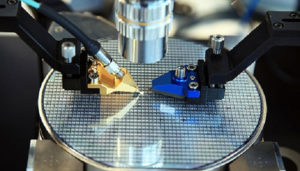 According to research firm MarketsAndMarkets, the Indian semiconductor market is forecast to be worth $32.35 billion by 2025 – growing at a CAGR of 10.1% between 2018 and 2025. The country is currently developing its domestic manufacturing industry of electronic systems design (ESDM), with a base of more than 120 companies. Around 2,000 chips are designed every year in India, according to the Department of Electronics and Information Technology (DeitY), and more than 20,000 engineers work on different aspects of chip design and verification.
According to research firm MarketsAndMarkets, the Indian semiconductor market is forecast to be worth $32.35 billion by 2025 – growing at a CAGR of 10.1% between 2018 and 2025. The country is currently developing its domestic manufacturing industry of electronic systems design (ESDM), with a base of more than 120 companies. Around 2,000 chips are designed every year in India, according to the Department of Electronics and Information Technology (DeitY), and more than 20,000 engineers work on different aspects of chip design and verification.
Thanks in part to the government's Make in India (an initiative to stimulate job creation and upskilling), the ESDM industry is expected to receive proposals worth Rs 10,000 crore (Rs 1.5 billion). dollars) in the coming years.
However, the increase in demand for semiconductors in several industries is affecting the pace of production in the sector. Accelerated processing without standards can lead to defects or failures. High-quality processes and equipment in factories are essential to ensure product success.
How does the environment affect the quality of semiconductors?
Excess moisture during semiconductor manufacturing typically leads to corrosion of its circuit equipment. In fact, moisture is responsible for 23% of lost revenue in semiconductor manufacturing. In these environments, condensation on the exterior of the microchip circuitry will likely result in operational malfunction of the semiconductors.
How to protect semiconductors?
When manufacturing microchips or semiconductors, it is important for the manufacturer to adhere to specific humidity contingencies. The materials used during processing, arrangement and assembly are hygroscopic and highly sensitive to moisture.
Industrial dehumidifiers are a way of ensuring ideal conditions (30% relative humidity at 200°C). Dehumidifiers regulate relative humidity and dew point in a variety of industrial applications, such as archival storage facilities, waste and freshwater treatment plants, indoor breeding facilities and industries where humidity control is essential.
However, choosing the right dehumidifier for a plan requires careful consideration such as plant size, air quality, and other requirements.
It is important to consider the following processes and equipment during manufacturing and the potential effects of excess moisture.
Set. Moisture adversely affects the bonding process and increases corrosion deficiencies in integrated circuit and semiconductor manufacturing. Polymeric compounds, known as photoresists, are hygroscopic. These compounds are used in manufacturing circuit lines for transferring methods into semiconductors, and when in contact with moisture, these lines can break or bridge – ultimately causing the circuit to malfunction.
Photolithography . Ideally, humidity in the photolithography room of a manufacturing facility should be between 20 and 35 percent RH at 200°C. Percentages above this may result in irregular adhesion of the photoresists. This can affect surface deficiencies and create stress cracks in the product.
Wafer manufacturing. During wafer manufacturing, spinners spray developer onto the wafer surface. This causes the solvent on the wafer to evaporate, producing vapor on the wafer surface. In turn, this also modifies the developer, causing the wafer surface to swell.
Vacuum devices. Excess humidity in an environment can also affect other plant equipment. For example, cryogenic pumps can become inactive due to water vapor pressure. However, if humidity levels are between 30 to 35 percent, the equipment's processing speed remains optimal.
To ensure an ideal manufacturing environment free from excess humidity, an industrial dehumidifier is essential. A high-quality dehumidifier will provide long-term production benefits and cost savings while preserving the semiconductor production process.

